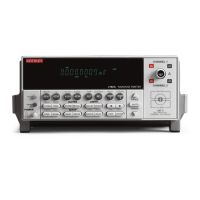Introduction
This section explains how to handle, clean, and disassemble the Model 2182. Disassembly
drawings are located at the end of this section.
Handling and cleaning
To avoid contaminating PC board traces with body oil or other foreign matter, avoid touching
the PC board traces while you are repairing the instrument. Some board areas have high-
impedance devices or sensitive circuitry where contamination could cause degraded
performance.
Handling PC boards
Observe the following precautions when handling PC boards:
• Wear cotton gloves.
• Handle PC boards only by the edges and shields.
• Do not touch any board traces or components not associated with repair.
• Do not touch areas adjacent to electrical contacts.
• Use dry nitrogen gas to clean dust off PC boards.
Solder repairs
Observe the following precautions when soldering a circuit board:
• Use an OA-based (organic activated) flux, and take care not to spread the flux to other
areas of the circuit board.
• Remove the flux from the work area when you have finished the repair by using pure
water with clean, foam-tipped swabs or a clean, soft brush.
• Once you have removed the flux, swab only the repair area with methanol, then blow dry
the board with dry nitrogen gas.
• After cleaning, allow the board to dry in a 50°C, low-humidity environment for several
hours.
5-2 Disassembly

